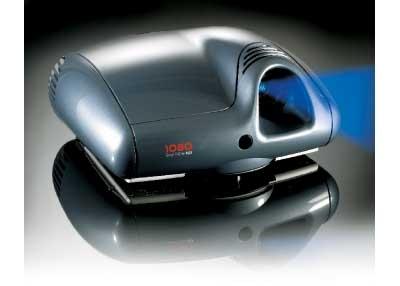Sim2 HT3000 1080p DLP Front Projector

Video front projectors have always been the best way to watch movies at home, and now that new 1080p models capable of unveiling all the detail in high-def sources have arrived, there's even more reason to get keyed up about the category. The Sim2 HT3000 1080p DLP front projector is one of the first to feature Texas Instruments' new discrete 1,920 x 1,080-pixel Digital Light Processing technology. A single-chip model with a seven-segment color wheel and full 10-bit video processing, the HT3000 sells for $15,995 with a standard 1.5-2.0x zoom lens.
With numerous less costly 1080p projectors out there, including current LCoS models from Sony and JVC and forthcoming single-chip DLPs from companies such as Runco, Sharp, and Optoma, the Sim2's high price tag might seem hard to swallow. But then again, the HT3000 isn't an ordinary projector. Along with its high-rez picture and Euro-slick looks, a lot of this model's appeal lies in its versatile setup features: a vertical lens-shift function to simplify installation, motorized zoom and focus, variable overscan, 36-step user-adjustable color temperature, and 12 gamma presets optimized for conditions ranging from bright daylight to total darkness. Don't try and tell me that Sim2 doesn't give you the tools to make pictures look good.
 The curved lines of the HT3000's dark gray metal-flake case give it a sports car-like appeal. Even so, the projector's low-profile design and relatively quiet fan (compared to others) mean you probably won't notice it suspended from a ceiling. The HT3000's back-panel inputs represent pretty much every connector you'd want, including two HDMI jacks (both accept 1080p signals), VGA, and component-video/RGB+H/V. Unfortunately, there's no DVI digital video input, which some installers prefer to HDMI because it has a more physically secure connector.
The curved lines of the HT3000's dark gray metal-flake case give it a sports car-like appeal. Even so, the projector's low-profile design and relatively quiet fan (compared to others) mean you probably won't notice it suspended from a ceiling. The HT3000's back-panel inputs represent pretty much every connector you'd want, including two HDMI jacks (both accept 1080p signals), VGA, and component-video/RGB+H/V. Unfortunately, there's no DVI digital video input, which some installers prefer to HDMI because it has a more physically secure connector.
Most people use video projectors in dim rooms; fortunately, the Sim2's remote was easy to operate in the dark. It has a fully backlit keypad and a cluster of number buttons for directly switching inputs. You navigate menus via arrow keys, using a set of plus- and minus-labeled buttons to quickly flip through the submenus.
The Format button offers up a wide range of display (aspect ratio) modes:Normal and Anamorphic, for standard 4:3 and widescreen 16:9 DVDs and HDTV; Panoramic and Letterbox, for filling a 16:9 screen with standard and letterboxed 4:3 pictures; Subtitle, which raises the picture; and Pixel-to-Pixel, which maps pixels from incoming signals to the display chip on a one-to-one basis. There are also three User modes that store custom horizontal and vertical picture dimensions.
- Log in or register to post comments














































